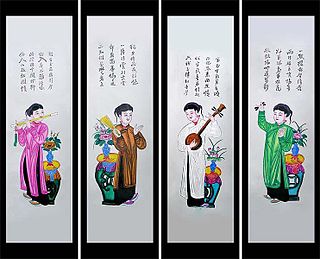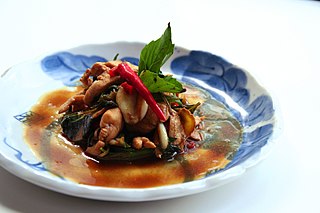
American Chinese cuisine is a cuisine derived from Chinese cuisine that was developed by Chinese Americans. The dishes served in many North American Chinese restaurants are adapted to American tastes and often differ significantly from those found in China.

Vietnamese cuisine encompasses the foods and beverages originated from Vietnam. Meals feature a combination of five fundamental tastes : sweet, salty, bitter, sour, and spicy. The distinctive nature of each dish reflects one or more elements, which are also based around a five-pronged philosophy. Vietnamese recipes use ingredients like lemongrass, ginger, mint, Vietnamese mint, long coriander, Saigon cinnamon, bird's eye chili, lime, and Thai basil leaves. Traditional Vietnamese cooking has often been characterised as using fresh ingredients, not using much dairy or oil, having interesting textures, and making use of herbs and vegetables. The cuisine is also low in sugar and is almost always naturally gluten-free, as many of the dishes are rice-based instead of wheat-based, made with rice noodles, papers and flour. Vietnamese cuisine is strongly influenced not only by the cuisines of neighboring China, Cambodia and Laos, but also by French cuisine due to French colonial rule over the region from 1887 to 1954.

Pad thai, phat thai, or phad thai, is a stir-fried rice noodle dish commonly served as a street food in Thailand as part of the country's cuisine. It is typically made with rice noodles, shrimp, peanuts, a scrambled egg, and bean sprouts. The ingredients are fried in a wok.

Fried rice is a dish of cooked rice that has been stir-fried in a wok or a frying pan and is usually mixed with other ingredients such as eggs, vegetables, seafood, or meat. It is often eaten by itself or as an accompaniment to another dish. Fried rice is a popular component of East Asian, Southeast Asian and certain South Asian cuisines, as well as a staple national dish of Indonesia. As a homemade dish, fried rice is typically made with ingredients left over from other dishes, leading to countless variations. Fried rice first developed during the Sui Dynasty in China.
Sweet and sour is a generic term that encompasses many styles of sauce, cuisine, and cooking methods. It is commonly used in East Asia and Southeast Asia and has been used in England since the Middle Ages. Sweet and sour sauce remains popular in Asian and Western cuisines.

Adobo or adobar is the immersion of cooked food in a stock composed variously of paprika, oregano, salt, garlic, and vinegar to preserve and enhance its flavor. The Portuguese variant is known as carne de vinha d'alhos. The practice, native to Iberia, was widely adopted in Latin America, as well as Spanish and Portuguese colonies in Africa and Asia.

Cashew chicken is a Chinese-American dish that combines chicken, with cashew nuts and either a light brown garlic sauce or a thick sauce made from chicken stock, soy sauce and oyster sauce.

Sanbeiji is a popular chicken dish in Chinese cuisine and one of the most iconic dishes of Jiangxi cuisine. The dish originates from the Jiangxi province of southern China, and is a specialty of Ningdu where the population are Hakka. The dish has become especially popular in Taiwan, being introduced to the island by the Hakka people. It is also served as a postpartum confinement food by the Chinese community of Malaysia. The Jiangxi style has a complex flavor and is spicy, while the Taiwan variant has a more simplistic flavor and is non-spicy.

Filipino cuisine is composed of the cuisines of more than a hundred distinct ethnolinguistic groups found throughout the Philippine archipelago. A majority of mainstream Filipino dishes that compose Filipino cuisine are from the food traditions of various ethnolinguistic groups and tribes of the archipelago, including the Ilocano, Pangasinan, Kapampangan, Tagalog, Bicolano, Visayan, Chavacano, and Maranao ethnolinguistic groups. The dishes associated with these groups evolved over the centuries from a largely indigenous base shared with maritime Southeast Asia with varied influences from Chinese, Spanish, and American cuisines, in line with the major waves of influence that had enriched the cultures of the archipelago, and adapted using indigenous ingredients to meet local preferences.

Yangzhou fried rice, also known by several other spellings and names, is a popular Chinese wok-fried rice dish. There are many varieties but it most properly describes egg fried rice with mixed vegetables and two forms of protein, typically pork and shrimp with scallions.

Japanese Chinese cuisine, also known as Chūka, represents a unique fusion of Japanese and Chinese culinary traditions that have evolved over the late 19th century and more recent times. This style, served predominantly by Chinese restaurants in Japan, stands distinct from the "authentic Chinese food" found in areas such as Yokohama Chinatown. Despite this difference, the cuisine retains strong influences from various Chinese culinary styles, as seen in the Shippoku cooking style.

Pakistani Chinese cuisine comprises the styles and variations of Chinese cuisine that are cooked and consumed in Pakistan. Chinese migrants to Pakistan have developed a distinct Pakistani-style Chinese cuisine.

Puerto Rican Chinese cuisine is a popular style of food exclusive to restaurants in Puerto Rico developed by its Chinese immigrants. The food is a variation of Cantonese cuisine with some elements of Puerto Rican cuisine. A typical dish consists of fried rice, a choice of meat, and French fries. The fried rice itself varies in every restaurant, but can contain many ingredients such as ham, beef, shrimp, egg, lettuce, and onions. In 2020, there were an estimated 450 Chinese restaurants in Puerto Rico.

Kung Pao chicken, also transcribed Gung/Gong Bao or Kung Po, is a spicy, stir-fried Chinese dish most commonly made with cubes of chicken, peanuts, vegetables and chili peppers, though subject to regional variations.

Phat Kaphrao, also spelled pad krapow, pad kaprao, or pad gaprao, is one of the most popular Thai dishes in Thailand. Known colloquially as "The No-brainer Menu", this dish has garnered a reputation for its appetising appearance and flavour.

Australian Chinese cuisine is a style of cooking developed by Australians of Chinese descent, who adapted dishes to satisfy local Anglo-Celtic tastes. Its roots can be traced to indentured Chinese who were brought to work as cooks in country pubs and sheep stations.

Mala xiang guo, roughly translated into English as "spicy stir-fry hot pot", is a Chinese dish prepared by stir frying. Strongly flavored with mala, it often contains meat and vegetables, and has a salty and spicy taste. The preparation process involves placing the required ingredients in the pot, stir frying and adding seasoning. In restaurants, customers usually choose the ingredients by themselves before the chef prepares the dish.

Eight treasure duck, also known as eight treasures duck, is a duck dish in Shanghai and Cantonese cuisine. Its name derives from the fact that it is stuffed with eight other ingredients, including rice, mushrooms and shrimp.
















